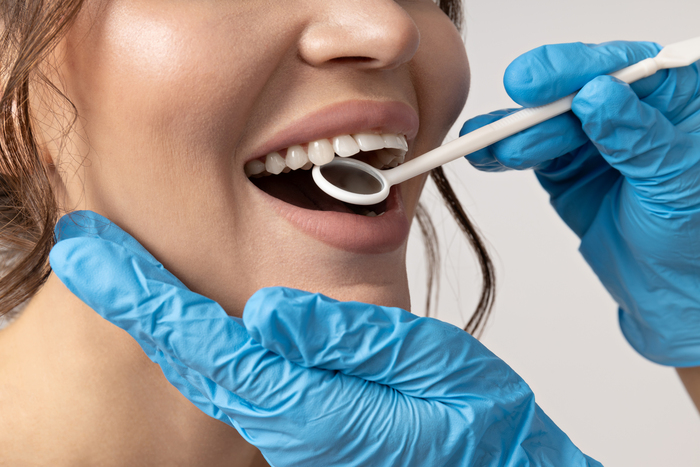What Is Enamel Erosion?
Enamel erosion refers to the progressive loss of the tooth's outermost layer due to chemical processes that do not involve bacterial activity, according to the ADA. They note that this condition can lead to a variety of dental problems, including increased sensitivity, discoloration, and a heightened risk of cavities.
Dental erosion occurs when acids wear away the enamel on your teeth, according to the ADA. Unlike decay caused by bacteria, this type of erosion is primarily due to exposure to acidic substances, such as certain foods and beverages, or even stomach acids in cases of acid reflux. Over time, these acids soften and dissolve the minerals in the enamel, leading to its gradual thinning and eventual loss. Factors such as frequent consumption of carbonated drinks, citrus fruits, and even some medications can contribute to this erosive process.
The consequences of enamel erosion can be significant. As the enamel wears away, the underlying dentin becomes exposed, leading to increased tooth sensitivity to hot, cold, or sweet stimuli. Additionally, the loss of enamel can result in noticeable changes in the appearance of your teeth, such as discoloration or a translucent look at the edges. Without the protective barrier of enamel, teeth are also more susceptible to cavities and other forms of decay, making it essential to address the issue promptly through appropriate dental care and lifestyle adjustments.
How Common Is Tooth Erosion?
Tooth erosion is a prevalent dental issue in the United States, affecting a significant portion of the population. According to the ADA, approximately 45% of adolescents and 80% of adults show some degree of enamel erosion. They note that the condition is becoming increasingly common due to dietary habits that include frequent consumption of acidic foods and beverages, as well as lifestyle factors such as acid reflux and certain medications. These statistics highlight the importance of awareness and proactive dental care to mitigate the risks associated with enamel erosion.
Signs of Enamel Erosion at Different Stages
Understanding the signs of enamel erosion at its various stages is crucial for early detection and intervention, according to the ADA. They explain that this is because enamel erosion can progress gradually, and recognizing the symptoms at each stage can help you take the necessary steps to protect your dental health.
Below are some common signs of dental erosion that you may notice as the condition advances, according to the ADA:
-
Sensitivity to Certain Foods: Early stages of enamel erosion often result in increased sensitivity, particularly to sweet, acidic, or spicy foods.
-
Teeth Discoloration: As the enamel wears away, the underlying dentin, which is yellowish in color, becomes more visible, leading to noticeable discoloration of the teeth.
-
Pain Due to Extreme Temperatures: In more advanced stages, you may experience sharp pain or discomfort when consuming hot or cold foods and beverages, as the exposed dentin is more sensitive.
-
Small Indentations: The loss of enamel can cause small indentations or pits to form on the surface of the teeth, often visible upon close inspection.
-
Cracked or Chipped Teeth: Weakened enamel is more prone to damage, leading to cracks or chips in the teeth, which can further exacerbate the erosion process.
-
Smooth, Shiny Surfaces: In some cases, the eroded areas of the teeth may appear unusually smooth and shiny as the enamel continues to wear away.
Recognizing these signs early can help you seek timely dental care and implement preventive measures to halt the progression of enamel erosion.
What Causes Tooth Erosion?
Tooth erosion can result from a variety of factors, each contributing to the gradual wear and tear of the enamel, according to the ADA. Understanding these causes is essential for implementing effective preventive measures and maintaining optimal dental health.
Below are some common causes of dental erosion, as listed by the ADA:
-
Teeth Grinding (Bruxism): The habitual grinding or clenching of teeth, often during sleep, can cause significant wear and tear on the enamel, leading to erosion over time.
-
Gastroesophageal Reflux Disease (GERD): Chronic acid reflux exposes the teeth to stomach acids, which can erode the enamel and increase the risk of dental erosion.
-
Dry Mouth (Xerostomia): A lack of sufficient saliva can reduce the natural protection against acids, making the teeth more vulnerable to erosion. Saliva helps neutralize acids and wash away food particles.
-
Brushing Your Teeth Too Hard: Using excessive force or a hard-bristled toothbrush can wear down the enamel, especially if combined with abrasive toothpaste.
-
Use of Medications: Certain medications, such as antihistamines, can slow saliva production, leading to a dry mouth and increasing the risk of enamel erosion.
-
Genetic Disorders: Conditions like enamel hypoplasia, which result in the underdevelopment of enamel, can make teeth more susceptible to erosion from an early age.
-
Bulimia Nervosa: This eating disorder involves frequent vomiting, which exposes teeth to stomach acids and can lead to significant enamel erosion.
Recognizing these causes can help you take proactive steps to protect your enamel and maintain your dental health.
How to Prevent Enamel Damage
Preventing enamel damage is essential for maintaining strong, healthy teeth and avoiding the complications associated with enamel erosion, according to the ADA. They note that by adopting a few simple habits and making mindful choices, you can significantly reduce the risk of enamel wear and protect your dental health.
Below are some effective strategies to prevent dental erosion, according to the ADA:
-
Consume Acidic Food and Drinks Only at Mealtime: Limiting the intake of acidic foods and beverages to mealtimes reduces the frequency of acid exposure, helping to protect your enamel.
-
Cancel Out the Acid After a Meal with Milk or Cheese: Consuming dairy products like milk or cheese after a meal can help neutralize acids in the mouth, providing a protective effect on your enamel.
-
Don’t Hold What You Drink in Your Mouth: Swallowing beverages promptly rather than holding them in your mouth minimizes the contact time between acids and your teeth.
-
Don’t Brush Your Teeth Until One Hour After Eating Acidic Food: Waiting at least an hour before brushing allows your saliva to neutralize the acids, reducing the risk of enamel damage from brushing.
-
Brush Your Teeth Twice a Day: Maintaining a regular brushing routine helps remove food particles and plaque, which can contribute to enamel erosion if left unchecked.
-
Use Fluoride Toothpaste and Don’t Rinse It with Water: Fluoride toothpaste helps strengthen enamel and protect against decay. Avoid rinsing with water immediately after brushing to allow the fluoride to remain on your teeth longer.
Implementing these preventive measures can go a long way in preserving the integrity of your enamel and ensuring long-term dental health.
How to Restore Tooth Enamel Naturally
Tooth enamel, once lost, does not regenerate or grow back naturally, as it lacks the living cells necessary for self-repair, according to the Australian Dental Association. They explain that unlike other tissues in the body, enamel cannot undergo the healing process, making it crucial to protect it from damage in the first place. While you cannot restore lost enamel, there are ways to strengthen and remineralize the remaining enamel to enhance its resilience and protect against further erosion.
Tooth Enamel Erosion Treatment
Treating tooth enamel erosion effectively requires a tailored approach based on the severity and stage of the condition, according to the ADA. They explain that early detection and intervention can help manage the symptoms and prevent further damage.
Most dentists offer various treatment options to address enamel erosion, ranging from preventive measures to restorative procedures. Below are some common recommendations your dentist may provide, depending on the stage of enamel erosion:
-
Topical Fluoride: For early-stage enamel erosion, your dentist may recommend the application of topical fluoride treatments. Fluoride helps to remineralize the enamel, making it more resistant to acid attacks and reducing sensitivity.
-
Dental Bonding: In cases of advanced enamel erosion, dental bonding can be used to restore the appearance and function of the affected teeth. This procedure involves applying a tooth-colored resin to the eroded areas, which is then shaped and hardened to provide a protective layer.
-
Dental Crowns: For severe enamel erosion, dental crowns may be necessary to cover and protect the damaged teeth. Crowns provide a durable, long-lasting solution that can improve both the aesthetics and functionality of your teeth.
-
Customized Mouthguards: If bruxism (teeth grinding) is contributing to enamel erosion, your dentist may recommend a custom-fit mouthguard to wear at night. This can help prevent further wear and protect your teeth from additional damage.
By following your dentist's recommendations and maintaining good oral hygiene practices, you can manage enamel erosion effectively and preserve your dental health.
FAQs
What is enamel erosion?
Enamel erosion is a dental issue where the protective outer layer of your teeth gets worn away, leading to increased sensitivity, discoloration, and a higher risk of cavities.
What causes enamel erosion?
Enamel erosion is primarily caused by exposure to acidic substances. This can come from certain foods and beverages or from stomach acids in cases of acid reflux. Other factors can include teeth grinding, dry mouth, brushing too hard, certain medications, genetic disorders, and bulimia nervosa.
What are the signs of enamel erosion?
Signs of enamel erosion include increased sensitivity to certain foods, teeth discoloration, and pain due to extreme temperatures.
How can I prevent enamel erosion?
You can prevent enamel erosion by consuming acidic food and drinks only at mealtime, canceling out the acid after a meal with milk or cheese, not holding what you drink in your mouth, waiting an hour after eating acidic food to brush your teeth, brushing twice a day, and using fluoride toothpaste.
What are the treatments for enamel erosion?
Treatment for enamel erosion depends on the severity and stage of the condition. It can range from topical fluoride treatments to dental bonding, dental crowns, and customized mouthguards.
Can enamel regenerate once it's worn away?
No, unlike other tissues in the body, enamel cannot regenerate or be replaced once it's worn away.
Can certain medications contribute to enamel erosion?
Yes, the use of certain medications can contribute to the erosive process.
Does acid reflux contribute to enamel erosion?
Yes, stomach acids from acid reflux can contribute to enamel erosion.



